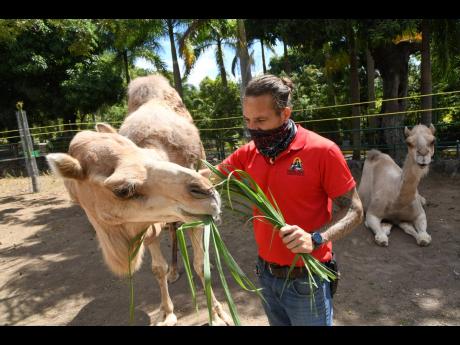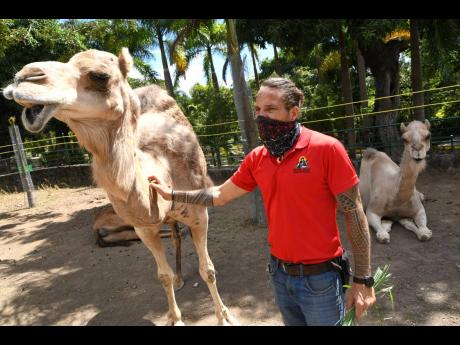Hope Zoo gets camels
The joy could not be hidden as curator of the Hope Zoo, Joey Brown, interacted with the attraction's latest additions.
The zoo welcomed three camels, Riatta, Katy and Moses on January 25, after they were donated by adventure attraction Yaaman Adventures, in St Ann.
When the news team visited the zoo, the camels were sitting idly outside their 1500 square feet, Sahara-inspired homes. And though there were no sand dunes, the camels were comfortably soaking in the afternoon's sun.
"The zoo is a great space during COVID, even if there are a couple of people here, it is still spread out and there is plenty of space up here. We are trying to add more attractions to improve the experience as just a relaxing space," Brown shared. The camels eat up to $3,000 worth of grains and hay daily.
"They have split in their lips so they can get off any kind of forage in the wild or in the desert. They have special thorny gums which help them digest like actually thorns. They do great in our climate, it's just a little bit wet in the wet season but they love it. They have a nice big area to roam; we even take them for walks in the hills," Brown explained.
Widely accepted
He said the camels are widely accepted by those who visit the zoo, especially for their size and interactivity. But, the zookeepers and staff have been trained with providing better care for the camels. There is a pending workshop with the San Diego Zoo via Zoom to add more knowledge, such as administering medication.
"They are pretty easy animals to work with but they are just so big and can be potentially dangerous. Luckily, these ones are social and friendly but they can get spooked and they are so big, it would be easy for someone to get harmed or injured. You have to be careful around them," he said.
Brown said, while the pandemic has slowed down the process of bringing more animals to the island, he is seeking to add tigers, jaguars, grizzly bears, zebras and a male kangaroo. He also has aspirations to build a walk-in aviary, to bring a feel of the jungle with tropical birds flying around.
"Obviously, I want to expand the animal collection and to get more keeper-guest-animal interaction. People come here, we didn't want them just walking around but to have a learning experience and just to educate people and connecting them with animals some more and have them get a greater appreciation for wildlife in general and to take better care of the environment around them," he told THE STAR.
Kenny Benjamin, executive chairman of the Hope Zoo Preservation Project, said the camels will show the 60-year-old zoo as "the best little zoo in the world".
"It's going to be a little zoo, given that we have limited acreage, but we want to maintain the gardens and just fill them with animals. I think we are there; we are the best in this hemisphere, when you refer to Trinidad and Barbados, we are way ahead. This is going to be the premier zoo in the Caribbean," Benjamin said.








































